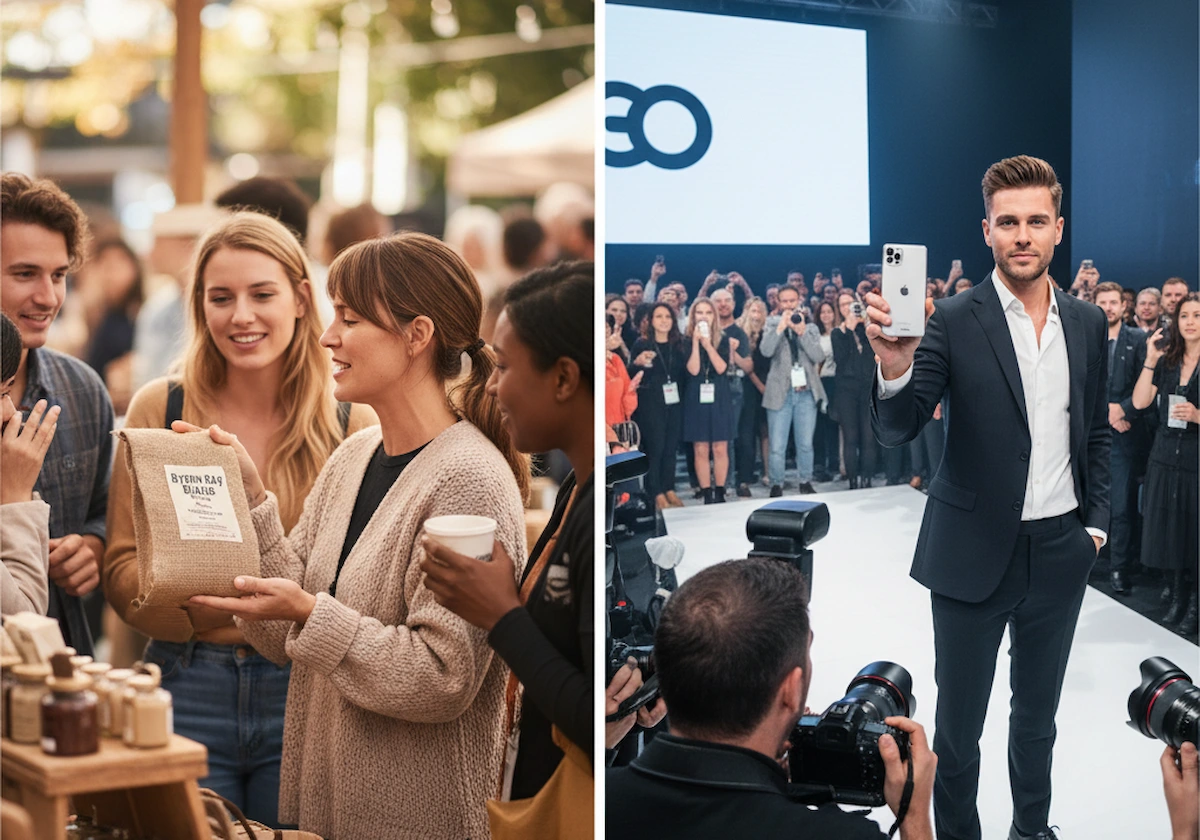Welcome to our guide on micro vs mega influencers.
Here’s a quick rule of thumb. Micro-influencers are better for building trust and driving engagement because their audiences feel more connected to them. But mega-influencers are better for broad reach and instant visibility, thanks to their huge followings.
But it’s not that simple. There’s more detail to it.
In this guide, we’ll cover what mega and micro-influencers are and how to measure brand awareness in your marketing campaigns. You’ll also learn how to calculate return on investment for your influencer marketing, plus some useful strategies for 2025.
Read on to learn which approach delivers the biggest impact for your small brand.
Defining the Micro vs Mega Influencer Spectrum
The influencer world ranges from creators with under 10,000 followers to stars with millions. Small businesses specifically need to understand this difference to avoid wasting money and get the most from their short budgets.
Below, we’ll explain in detail what mega and micro-influencer levels mean and what makes each tier useful. Once you understand the distinctions, you can make choices based on real facts.
Understanding Mega and Macro-Influencers
Mega influencers are those who have over a million followers on their social media accounts. These people work like TV stars because they share messages with huge audiences. Think of someone like Selena Gomez with her 402 million Instagram followers. She can reach almost everyone, but only one post from her can cost around $2.5 million.

Just below mega influencers, you’ll find macro influencers with 500,000 to one million followers. They still have big audiences but cost much less than megastars (cheaper, yes… but still nowhere near ‘budget-friendly’).
Most of the macro creators built their following through great social media content rather than being famous for other things first. These creators give you credibility and recognition without the celebrity price tag.
Now, both influencer types work well when you want to make lots of people aware of your brand or launch new products. Their huge networks can make an unknown brand famous almost overnight.
The Value of Micro and Nano-Influencers
When you move down the scale, micro-influencers have between 10,000 and 100,000 followers in specific areas they know really well. These creators understand their communities deeply and make content that feels authentic instead of like a polished advert.
Next up are nano influencers who have fewer than 10,000 followers (usually between 1,000 and 10,000 people). Their followers see them more like trusted friends than distant celebrities. These creators reply to comments personally and have good relationships with their communities.
You might be wondering what makes these smaller influencers so powerful. Well, their followers truly pay attention. Like, when a nano influencer talks about a skincare product, people pay attention. They jump into the comments, exchange opinions, and spark real conversations.
Take Sydney creator Katie (@itsalfieandme) as a live example. She runs an account about her cocker spaniel, Alfie, and connects with a loyal pet-loving community. She currently has ~85,000 followers with double-digit engagement, which signals an active audience and lively comment threads. Her followers tag other dog owners, share tips, and share stories about their pets.
Pro Tip: Before you partner with any influencer, check how many followers are authentic and active. Tools like HypeAuditor or Modash can help you identify fake followers and ensure your budget goes toward genuine engagement.
Comparing Core Attributes: Reach vs. Engagement
Now let’s look at the two main ways to measure how well influencers work: reach and engagement. Reach is about how many people see your post, while engagement says how people react once they’ve seen your post (it’s basically ‘seen vs. cared’).
Let’s discuss reach first, followed by engagement.
Reach
Reach shows how far your message spreads and how large your audience could be. For example, a mega influencer might reach millions of people. That said, a wide reach doesn’t always mean people will care about the post.
Engagement
Engagement shows what people do with a post. It counts likes, comments, shares, and saves. When you have high engagement, it means the audience feels involved because they stop, reply, and sometimes even try what the creator recommends.
What Should Small Businesses Prioritise?
Frankly, the numbers tell a clear story. Micro influencers get about 3.86% engagement on Instagram, but mega influencers drop to about 1.21%. Meanwhile, nano influencers sometimes reach close to an impressive 10% engagement.
The engagement versus reach comparison creates a big dilemma for small brands. Would you rather have millions of people casually scroll past your message or thousands of people who stop and think about buying from you?
If you run a service-based business and want real customers, go for micro-influencers. They earn trust fast and make people feel comfortable reaching out. For bigger campaigns or brand launches, mega-influencers work better because they spread your name far and wide.
Know what you want before you spend a cent. That’s where good marketing begins.
Measuring Brand Awareness in Marketing Campaigns
In practice, the choice between micro and mega-influencers depends on your goal. Many campaigns begin with brand awareness, which ensures people learn about your brand’s existence. But if visibility is your target, you need to measure exposure first and track sales later.

Here are the main numbers that show if people are seeing your brand and talking about it:
- Impressions: When you check impressions, you see how many times your content showed up on screens. Unlike reach, it counts repeat views. So, if one person sees your post three times, that equals three impressions. The number gives you a basic idea of how much visibility your campaign got overall.
- Audience Growth: You can track audience growth by seeing how many followers you gain during a campaign. Compare the before and after numbers, and see if it rises. In that case, it’ll mean people liked your content enough to stick around.
- Website Referral Traffic: The data in your website analytics shows how many people clicked from influencer posts. With tools like Google Analytics, you see which platforms send traffic. And if lots of people click, the content clearly sparked curiosity.
- Social Mentions and Shares: It’s a good idea to track social mentions to see how often people talk about your brand or use campaign hashtags. Specifically, shares are powerful because they spread your message further and help followers act like your mini-ambassadors.
How to Calculate Influencer Marketing ROI
Influencer marketing ROI is a way to measure whether you’re making more money than you’re spending on campaigns. You calculate this ROI by taking the money you made from a campaign, dividing it by what you paid, then multiplying by 100 to get a percentage.
Let’s go through how to create clear connections between your influencer posts and actual sales.
Attributing Conversions from a Target Audience
You need to create a clear path from an influencer’s post all the way to when someone buys your product.
Want to learn how to do it? Don’t worry. The methods we’ll discuss here will show you how your campaigns bring in actual money from specific customers.
These are the most reliable ways to track which influencers drive sales for your brand:
- Unique Discount Codes: If you give each influencer a unique discount code, you can track their sales clearly. Codes like ‘SARAH20’ or ‘MIKE15’ link purchases to a specific creator. The discount code method makes results easy to measure and compare across different partnerships.
- Custom Affiliate Links: Special tracking links show every click and purchase from a specific influencer. Each link has a code that follows visitors from the post to the checkout. Unlike discount codes, affiliate links also track full-price sales and give you more complete information.
- Dedicated Landing Pages: While discount codes and links help you see sales, campaign pages give deeper insight. This is because the campaign page shows purchases, browsing habits, and which content convinced people to buy.
Calculating Final Cost Per Acquisition (CPA)
Honestly, Cost Per Acquisition (CPA) is the most important number for figuring out if your campaign truly made money. It tells you how much you spent to get each new customer through your influencer campaigns.
The maths for CPA is pretty simple. Just take your total campaign cost and divide it by how many new customers you got (Total Campaign Cost / Number of Conversions = CPA).
For example, if you spent $1,000 on an influencer campaign and got 50 new customers, your CPA would be $20 per customer. This number shows you how efficient your campaign was and helps you compare how different influencers performed.
Pro Tip: Don’t forget to track late sales too. Because someone might see your product in an influencer’s post today, but only buy it a week later, after searching your brand again. In such cases, tools like Google Analytics help you connect those dots so you don’t miss these sales.
Building the Best Influencer Strategy for 2025
Why do some brands in Australia get influencer marketing right while others miss the mark? The answer lies in building a clear plan (planning sounds boring, but it saves cash). In 2025, most brands favour micro-influencers, while others mix influencer types for stronger results.
It’s time to build a system that helps you connect the right kind of influencer to your business goal for the best outcome. Are you ready? Keep reading.
A Goal-Oriented Framework for Influencer Selection
The thing is, some brands still pick particular influencers just because they look popular or cost less. But in reality, this method often leads to weak results. That’s why good campaigns understand first what kind of influencer they need based on what they want to achieve.

Here’s how to decide what kind of influencer you should get:
When to Prioritise Reach with a Mega-Influencer
Look, we’ll keep it straight: you should use mega-influencers when you launch a new product or enter a new market. In those moments, you need fast attention from as many people as possible.
Mega-influencers also help build excitement and connect your brand to a lifestyle. That said, smaller influencers can help too, but they rarely create the same quick impact (either way, you’re not doomed).
Now, big companies with large budgets, luxury brands that want to look exclusive, and businesses chasing wide audiences often see the strongest results with mega-influencers. You can think of them as a giant loudspeaker that spreads your message across the whole market at once. That’s it.
When to Prioritise Engagement with a Micro-Influencer
Let’s talk about when you should get micro-influencers. First, think about your goal. Do you want to boost sales in certain markets, build trust with communities, or get fresh content without spending too much? Micro-influencers do well in these areas because their followers truly trust their advice. They also build strong connections, and those connections often lead to real sales.
In other words, micro-influencers work best when you want people to buy instead of only noticing your brand. You can picture micro-influencers as a personal sales team that offers honest recommendations and motivates people to choose your products.
Adopting a Hybrid Model for Superior Results
Most strong brands in 2025 do not rely on only one type of influencer. Instead, they use a mix of different tiers to get stronger results. Like, a campaign might begin with a mega-influencer to spread the word quickly, then continue with micro-influencers who keep conversations alive and drive sales.
From our experience, Australian businesses often see the best results when they combine both types. In this approach, larger names create wide awareness at the start, and the smaller creators build trust that later turns interest into purchases.
The Role of an Influencer Marketing Agency
It’s unfortunate how influencer campaigns with different types of creators become complex fast. And it happens because a business needs to pick the right people, agree on fair prices, track how each deal performs, and make changes when results fall short.
But an influencer marketing agency makes this process easier. The agency helps by finding creators, managing deals, and checking performance so your team can focus on bigger goals. That support lets your team focus on the business while experts handle the complex parts.

Pro Tip: Always check how well an influencer’s style fits your brand voice. This is because a good match will make the partnership feel natural, while a bad fit can confuse your audience and waste money.
Making Data-Driven Influencer Decisions for Success
Small brands need to understand the different influencer levels, measure both brand awareness and actual sales, and build strategies based on what they want to achieve. The best approach is rarely one-size-fits-all because different situations call for distinct solutions.
In this guide, we’ve looked at how micro-influencers deliver higher engagement rates and better returns on investment. You’ve also learned how mega-influencers provide massive reach when you’re launching new products.
If you’re ready to build an influencer strategy that brings real results to your small brand, contact us today.
We help Brisbane businesses make influencer choices as part of a full marketing plan. Our team links influencer work with SEO, content, and ads so everything moves in the same direction.
